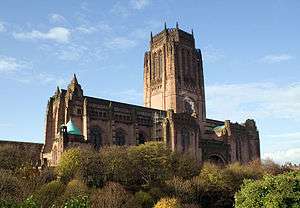Prudential Assurance Building, Liverpool
| Prudential Assurance Building | |
|---|---|
 Prudential Assurance Building | |
| General information | |
| Architectural style | Victorian, Gothic revival |
| Town or city | Dale Street, Liverpool |
| Country |
|
| Coordinates | 53°24′28″N 2°59′19″W / 53.4078°N 2.9887°WCoordinates: 53°24′28″N 2°59′19″W / 53.4078°N 2.9887°W |
| Construction started | 1855 |
| Completed | 1856 |
| Client | Prudential Assurance |
| Design and construction | |
| Architect | Alfred Waterhouse |
The Prudential Assurance Building is a Grade II listed, Victorian Gothic revival style office building located on Dale Street in the centre of Liverpool, England.

It was designed by local architect Alfred Waterhouse (also noted for the Natural History Museum and Manchester Town Hall) and was constructed in under a year in the mid-19th century.[1] The building was commissioned by the country's leading insurance provider Prudential as its new regional offices in Liverpool.[1] It was part of a series of buildings commissioned by the Prudential from Waterhouse including the firm's headquarters in Holborn, London. Like the other Prudential commissions, the building is noted for its use of red architectural terracotta and brick.[2] It has a tower which was added to the building by the architect's son Paul Waterhouse in 1905.[3] Exterior tiles between the first and second floor of the building read Prudential Assurance Buildings, the pluralism of this is somewhat inaccurate as it is in fact only one building.
Alongside the likes of Liverpool Town Hall, Bank of England Building, India Buildings, White Star Building and the Tower Buildings. The Prudential Assurance Building is amongst the most architecturally important buildings in the commercial district which is one of the six areas that constitute Liverpool's status as a UNESCO World Heritage Site.
See also
- Architecture of Liverpool
- Liverpool Maritime Mercantile City
- Listed buildings in Liverpool
- Dale Street
- List of commercial buildings by Alfred Waterhouse
References
- 1 2 "Prudential Assurance Building". The Liverpool Architectural Society. Retrieved 2010-03-30.
- ↑ The Edinburgh building is an exception in using sandstone.
- ↑ "Buildings of Dale Street". Liverpool World Heritage. Archived from the original on 28 August 2008. Retrieved 2010-03-30.


